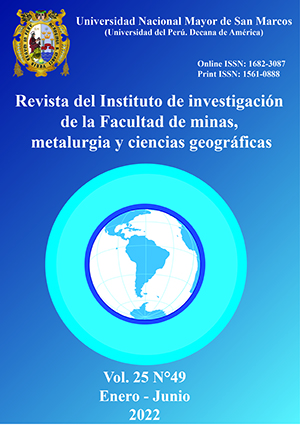Characterization of aquatic activities in the VRAEM area and its environmental impact
DOI:
https://doi.org/10.15381/iigeo.v25i49.23003Keywords:
Gross tonnage, river bikes, shipyard, basin, environmental liabilityAbstract
The objective of this research was to characterize the aquatic activities that take place in the Vraem area; as well as to identify the environmental liabilities and sources of anthropic contamination on the banks and marginal strips adjacent to the rivers, caused by the formation of urban drains due to the lack of wastewater treatment plants and sewage and drainage networks; accumulation and clogging of solid waste from water transport, houses and riverside food stalls, leachate from drug maceration ponds inserted into rivers by runoff and percolation, and sedimentation and soil erosion by extraction of alluvial material. The methodology was based on the execution of a non-experimental investigation, with the collection of data in the field from observation and measurement tools. A total of 297 boats and 86 chimpanzee-type riverboats were registered, navigating the main rivers of the Vraem in the jurisdictions of Pichari, Ivochote, Boca Anapati, Quiteni, Puerto Ocopa, Camisea and Mantaro, 67 embarkation and disembarkation areas for personnel and material, 15 river transport companies and 8 shipyards dedicated to the construction and repair of naval steel material ships, describing their technical characteristics and their structuring process, concluding that although water transport allows interconnection and development socioeconomic in the Vraem area, the lack of education and inadequate management in this activity generates a significant negative impact for the environmental components.
Downloads
Published
Issue
Section
License
Copyright (c) 2022 Alfonso Ramírez Caján

This work is licensed under a Creative Commons Attribution 4.0 International License.
AUTHORS RETAIN THEIR RIGHTS:
a. Authors retain their trade mark rights and patent, and also on any process or procedure described in the article.
b. Authors retain their right to share, copy, distribute, perform and publicly communicate their article (eg, to place their article in an institutional repository or publish it in a book), with an acknowledgment of its initial publication in the Rev. Inst. investig. Fac. minas metal cienc. geogr.
c. Authors retain theirs right to make a subsequent publication of their work, to use the article or any part thereof (eg a compilation of his papers, lecture notes, thesis, or a book), always indicating the source of publication (the originator of the work, journal, volume, number and date).






